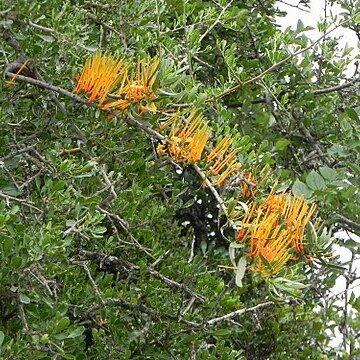Aerial, hemiparasitic shrub, up to 1 m high, essentially glabrous. Leaves alternate, opposite-subopposite, occasionally fascicled, somewhat coriaceous with age, linear-lanceolate to narrowly elliptic, glabrous, obscurely nerved, lower ones strongly ascending. Inflorescence a 4-6-flowered umbel, or occasionally racemose by addition of several flowers lower on rachis, axillary or solitary on older branches. Flowers 5-merous, tubular, bilaterally symmetrical (tube bearing a short, V-shaped, unilateral split), bright red to orange basally, yellow towards tip, apical portion blackish, mostly cylindrical but slightly expanded basally; lobes slightly longer than rest of corolla, spirally coiled following anthesis. Flowering time Apr.-Aug. Fruit an ellipsoid berry, reddish when mature, smooth.
Glabrescent stem parasite, up to 1 m tall. Leaves elliptic-lanceolate. Flowers 76-152 mm axillary umbels, tubular, base swollen, mouth V-shaped, 5 lobes coiling back, glabrous, orange-red and black-tipped. Berry red.
Glabrescent stem parasite to 1 m. Leaves subsessile, elliptic-lanceolate. Flowers in axillary umbels, glabrous, tubular with a basal swelling, 5-lobed, mostly orange but red below and with a black tip.
A shrub that grows attached to other plants. It grows 1 m tall. The leaves are narrowly sword shaped. The flowers are 7-15 cm and in groups in the axils of leaves. The fruit is a red berry.

